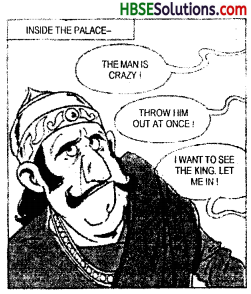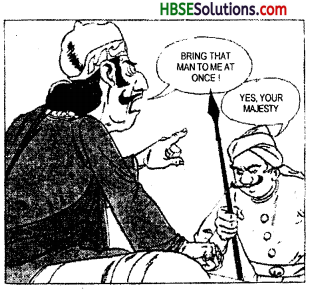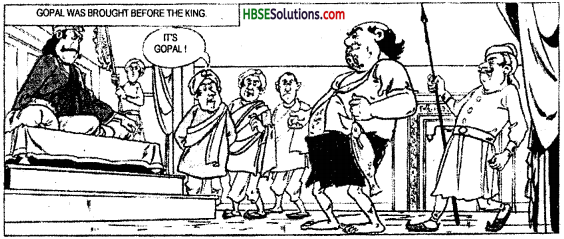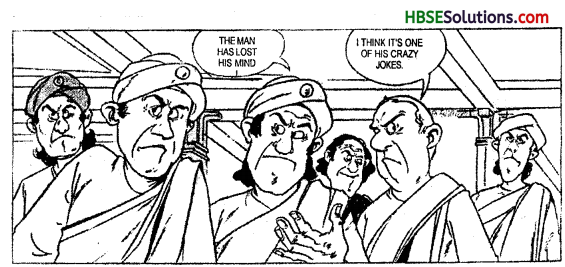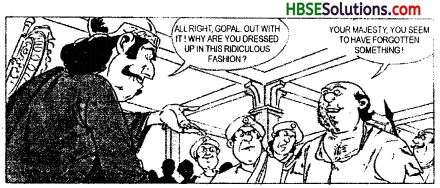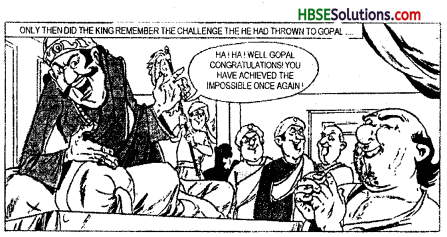Haryana Board 7th Class English Solutions Honeycomb Chapter 8 Fire: Friend and Foe
HBSE 7th Class English Fire: Friend and Foe Textbook Questions and Answers
Comprehension Check
Question 1.
Mark the correct answer in each of the following:
(i) Early man was frightened of
– आदि मानव डरता था।
(a) lightning and volcanoes.
(b) the damage caused by them.
(c) fire.
Answer:
(b) the damage caused by them.
(ii) Fire is
(a) Fire is energy.
(b) Fire is heat and light.
(c) Fire is the result of chemical reaction
Answer:
(c) Fire is the result of chemical reaction

Question 2.
From the boxes given below choose the one with the correct order of the following sentences.
(i) That is fire.
(ii) A chemical reaction takes place.
(iii) Energy in the form of heat and light is released.
(iv) Oxygen combines with carbon and hydro-gen.
(i) (ii) (iii) (iv)
(ii) (iii) (i) (iv)
(iv) (iii) (ii) (i)
(iv) (ii) (iii) (i)
Answer:
(iv) (ii) (iii) (i).
Working with The Text
Answer the following questions:
Question 1.
What do you understand by the ‘flash point’ of a fuel?
Answer:
Every fuel has a particular temperature. The temperature at which it begins to burn is called ‘flash point1 of a fuel.
Question 2.
(i) What are some common uses of fire?
Answer:
Fire is commonly used to cook our food, warm our homes in winter and to generate elec-tricity.
(ii) In what sense is it a “bad master”?
Answer:
It is a bad master if it gets out of control and burns the things which it engulfs.
Question 3.
Match items in Column A with those in Column B.
| A | B |
| (i) Fuel | : lighted matchstick
: air |
| (ii) Oxygen | : coal
: burning coal
: wood |
| (iii) Heat | : smouldering paper
: cooking gas |
Answer:
| A | B |
| (i) Fuel | : coal
: burning coal
: wood |
| (ii) Oxygen | : air |
| (iii) Heat | : lighted matchstick
: burning coal
: smouldering paper |
Question 4.
What are the three main ways in which a fire can be controlled or put out?
Answer:
Three things are needed for burning of the fuel. We can control in it we take away the fuel. We let fire did if do not add more fuel to it. The second way of putting out a fire is to prevent oxygen from reaching it. The third way of putting out fire is to remove the heat.

Question 5.
Match items in Box A with those in Box B:
Answer:
1. To burn paper or a piece of wood, we heat to before it catches fire.
2. Small fires can be put out with a damp blanket
3. When water is spread on fire, it absorbs heat from the burning material and lowers the temperature.
4. A carbon dioxide extinguisher is the best thing, to put out an electrical fire.
5. Space left between building reduces the risk of fire.
Question 6.
Why does a burning candle go out when you blow on it?
Answer:
When we blow on a burning match stick, we remove the hot air around the flame. This causes fall in temperature below the flash point. Thus the candle goes out.
Question 7.
Spraying water is not a good way of putting out an oil fire or an electrical fire. Why?
Answer:
If water is sprayed onto an oil fire, the oil will float on the top and continue to burn. Water can carry oil with it and continue to burn. Water should also not be used on fires caused by electrical appliances. The person might get an electric shock and get killed.
Question 8.
What are some of the things you should do to prevent a fire at home and in the school?
Answer:
Fire saving techniques are very important both at home and in school. At home fire can be controlled if all the the electrical appliances are earthed and insulated. There should aiways be a bucket of sand which can be of great help.
In the school we should perform demonstration drills so that students can be well equipped with ways to fight with fire. The school should have fire extinguishers which should always be ready for use.
HBSE 7th Class English Fire: Friend and Foe Important Questions and Answers
Very Short Answer Type Questions
Question 1.
What made early man discover fire?
Answer:
Watching lightning and volcanoes made him discover fire.
Question 2.
How did chemical reaction take place?
Answer:
Chemical reaction takes place when oxygen in the air combines with carbon and hydrogen in a fuel.
Question 3.
What is fire?
Answer:
Energy, released in the form of heat and light is called the fire.
Question 4.
Give examples of fuel.
Answer:
Wood, coal, cooking gas and petrol are examples of fuels.
Question 5.
In what condition can burning not take place?
Answer:
The burning can not takes place if the fire has no fuel to hired on.

Question 6.
How does spraying of water helps us?
Answer:
Spraying of water helps to absorb heat from the burning fuel and lowers the temperature.
Question 7.
What led to forming of human chain?
Answer:
As there were no fire men so when fire broke out, everybody became a fire fighter.
Question 8.
What are known as fire brigades?
Answer:
Fire-fighting workers with special equipment is known as fire brigades. They are highly trained people and possess many skills.
Short Answer Type Questions
Question 1.
How did man solve the puzzle regarding fire?
Answer:
The man learnt that fire is the result of a chemical reaction. When oxygen combines with carbon and hydrogen a chemical reaction takes place. Energy is released in form of heat and light.
Question 2.
How is it said that fire is a good servant but a bad master?
Answer:
Fire is a good servant as it helps to cook our food, warm our homes and to generate electricity. But it becomes a bad master when it gets out of control and thousands of homes and shops are damaged by fire.
Question 3.
What are three main ways which fire can be put out?
Answer:
There are three ways by which fire can be put out. If we take away the fuel, the fire has no fuel to feed on and no burning can take place. Secondly absence of oxygen can keep fire from reaching. Thirdly we can put off pre by removing the heat.
Question 4.
In which kind of cases water is not a useful fire to put off fire?
Answer:
If water is sprayed onto an oil fire, the oil will float on to the top of the water and continue to bum. Water can flow quickly, carrying the burning oil with it and spreading the fire. Water should also not be used on fires cause by electrical appliances as person spraying water can get an electric shock.

Question 5.
Who are fire fighters and how do they help us?
Answer:
Fire fighters are those who have special equipment, known as fire brigades who put out fires. They possess many skills’ and cut of electricity supply, knock down dangerous walls spray water other materials matrials to bring fire under
Some Other Questions For Examination
Question 1.
What are the three things used to make fire?
Answer:
The three used to make fire are fuel, oxygen and heat.
Question 2.
Give reason: When you blow smouldering paper, it often bursts into flame.
Answer:
When we blow on smouldering paper, it often bursts into flame because we blow air and oxygen comes from air which produces fire.
Question 3.
Why are small fires covered with a damp blanket or a sack?
Answer:
Small fires are covered with a damp blanket or a sack because this stops oxygen reaching the burning material.
Question 4.
Write three ways in which a fire can be put out.
Answer:
(a) take away the fuel
(b) prevent oxygen from reachling it.
(c) remove the heat.

Multiple Choice Questions
Tick (✓) the correct option.
Question 1.
Which of the following words means to burn in a suppressed manner’?
(a) Combine
(b) smouldering
(c) injured
(d) damp
Answer:
(a) Combine ✓
Question 2.
Which of the following statements is incorrect?
(a) Early man knew what fire was.
(b) Oxygen comes from the air.
(c) We use fire to generate electricity.
(d) Fire is very useful if it is kept under control.
Answer:
(c) We use fire to generate electricity. ✓
Question 3.
Fire is the result of a ……………… reaction.
(a) physical
(b) biological
(c) chemical
(d) none of these
Answer:
(c) chemical ✓
Question 4.
Which of the following are examples of fuel?
(a) wood
(b) coal and petrol
(c) cooking gas
(d) all of these
Answer:
(b) coal and petrol ✓
Question 5.
Space left between buildings
(a) reduces the risk of fire
(b) increases the risk of fire
(c) plays no role in fire
(d) none of these
Answer:
(a) reduces the risk of fire ✓

Make Sentences
Use the following words in sentences of your own:
energy, powerful, frightened, watched, dangerous.
(i) Energy: Eating healthy food gives us energy.
(ii) Powerful: The truth is the most powerful weapon.
(iii) Frightened: I was frightened by the horrible dream I saw last night.
(iv) Watched: I watched my favorite movie on television.
(v) Dangerous: It is dangerous to play with sharp objects.
Fire: Friend and Foe Passages for Comprehension
Read the passages given below carefully and answer the questions that follow:
Passage – 1
1. He must …………….. was frightened.
Questions:
(i) Name the lesson.
(ii) Who is He’?
(iii) What inspired early man to use fire?
(iv) Why was he frightened?
Answers:
(i) The name of the lesson is ‘Fire: Friend and Foe’.
(ii) ‘He’ is early man.
(iii) Early man got inspiration from watching lightning and volcanoes.
(iv) He was frightened since fire was powerful and dangerous.
Passage – 2
It is ………………. under control.
Questions:
(i) How is fire a good servant?
(ii) When does fire become a bad master?
(iii) Choose a word which is opposite of ‘useless’.
(iv) How is fire kept under control?
Answers:
(i) Fire is a good servant since it helps us to cook our food, warm our homes and to generate electricity.
(ii) Fire becomes a bad master when it gets out of control.
(iii) Useful
(iv) Fire is kept under control by raising the kindling temperature of the fuel.
Passage – 3
Just as ………………. taken away.
Questions:
(i) What three things are needed to start a fire?
(ii) Name two main ways by which fire can be put out.
(iii) Which thing is most important for burning?
(iv) Write three forms of verb ‘take’.
Answers:
(i) Fuel, oxygen and heat are needed to start a fire.
(ii) Fire can be put out by cut off supply of oxygen and spraying of carbon dioxide.
(iii) Air (Oxygen) is most important for burning.
(iv) Take, took, taken

Passage – 4
In doing is extinguished.
Questions:
(i) What is mant done?
(ii) What is menat by flash point?
(iii) How is water benefical to control fire?
(iv) Choose a word which means to put of fire.
Answers:
(i) The match stick or a candle is blown off.
(ii) The flash point is the temperature at which it begins to catch fire.
(iii) Water absorbs heat form the burning fuel and lowers the temperature.
(iv) Extinguished.
Passage – 5
When fire ………………… fire risk.
Questions:
(i) Why did every body became a. fire fighter?
(ii) How did forming of human chain help?
(iii) What reduces the fire risk?
(iv) Choose a woid which means ‘to lessen’.
Answers:
(i) Everybody become a fire fighter because there were no fire men.
(ii) Human chains helped to pass buckets of water from a well or a pond to the blaze.
(iii) Leaving the space between the buildings reduces the fire risk.
(iv) Reduce.
Passage – 6
Fire fighters are highly trained people. They possess many skills. They cut off electricity supply, knock down dangerous walls, spray water and other materials to bring fire under control. They are also trained in first aid so that they can help people suffering from burns or from the effects of smoke.
Questions:
(i) Who are fire-fighters?
(ii) What do they do?
(iii) How can training in first aid help in case of fire?
(iv) Choose a word which means antonym of ‘safe’.
Answers:
(i) The fire-fighters are the people who put out fire.
(ii) They can knock down dangerous walls, spray water and cut of electic supply.
(iii) The training of first aid can help people suffering from burns or from the effect of smoke.
(iv) Dangerous.

Fire: Friend and Foe Translation in Hindi
Before you read
Fire is ………………. control it?
पढ़ने से पहले
आग दोनों महत्त्वपूर्ण और खतरनाक है। आग क्या? हमने – इसे कैसे खोजा? हम इसका कैसे नियंत्रण कर सकते हैं?
1. Early man……………….. was frightened.
आदमी नहीं जानता था कि आग क्या है पर उसने जरूर देखा होगा कि वह क्या नुकसान पहुँचा सकती है। उसने प्रदीप्ति और ज्वालामुखी को आग के प्रयोग से बहुत पहले देखा होगा। आग शक्तिशाली और खतरनाक थी इसलिए वह उससे डरता था।
Word Meaning: Damage-destruction = नुकसान, Watched-to look = देखना, Volcanoes-A conical hill which = ज्वालामुखी, Powerful having power = शक्तिशाली, Frightened-To be scared = डर, Lightning an electric clouds = प्रदीप्ति।
2. Fire may ………… ………….. call fire.
आग ने आदि मानव को शायद दुविधा में डाला होगा पर अब हमें मालूम है कि आग रासायनिक प्रतिक्रिया का नतीजा है। जब वातावरण में आक्सीजन, कार्बन और हाइड्रोजन ज्वलन पदार्थ में मिलती हैं, तो रासायनिक प्रक्रिया होती है। इस प्रक्रिया में उष्मा और रोशनी के रूप में ऊर्जा निकलती है। इसे ही हम आग कहते हैं।
Word Meaning: Puzzled-perplexity = दुविधा, Result-to come out = परिणाम, Chemical reaction-Relating to chemistry = रासायनिक प्रक्रिया, Combines-to join = मिलाना, Energy-Power to do work = ऊर्जा, Released-Given out = निकलना, Process–proceeding = fafel
3. Three things ………………………. is heat.
आग के लिए तीन चीजों की आवश्यकता है, ईंधन, आक्सीजन और ऊष्मा या ताप। लकड़ी, कोयला, खाना बनाने की गैस और पेट्रोल ईंधन के कुछ उदाहरण हैं। आक्सीजन वायुमंडल में पाई जाती है। इसलिए जब तुम मन्द-मन्द जलते कागज पर फूक मारते हो तो वह लपटों से जलने लगता है। आग के लिए तीसरी चीज ताप की आवश्यकता होती है।
Word Meaning: Fuel-Material for burning = ईंधन, Air-a kind of mixture of gases = वायु, Blow-stream of air = पूर्वक मारना, Smouldering-to burn in a suppressed manner = मन्द-मन्द जलना।
4. Fuel and ………………………….. the fuel.
इंधन और ऑक्सीजन अपने आप से नहीं जलते, नहीं तो अखबार या डंडा अपने आप से खुले में पड़े जलने लग जाते।
कागज या लकड़ी के टुकड़े को जलाने से पहले हमें गर्म करना पड़ता है। हम ज्यादातर जलती माचिस से ऐसा करते हैं। हर ईंधन का एक विशेष दहन ताप होता है जिस पर वह जलने लगता है। इस तापमान को अधिक बिन्दु या ईंधन का प्रज्वलित तापमान कहते हैं।
Word Meaning: Generally-mostly = अधिकतर, Flash Point-Transient condition = क्षणिक व्यवस्था।
5. It is …………………………. under control.
कई बार कहा जाता है कि आग एक अच्छा नौकर है पर बुरा मालिक। इसका आशय है कि आग बहुत उपयोगी है जब तक इसे नियंत्रण में रखा जाए।
Word Meaning: Sometimes-occasionly a कई बार, Useful-necessary = जरूरी, Control-limit = नियंत्रण।
6. For instance ………………… or injured.
उदाहरण के लिए हम इसका प्रयोग खाना बनाने के लिए, सर्दियों में घर को गर्म करने के लिए और बिजली उत्पन्न करने में करते हैं। पर दूसरी तरफ अगर आग नियंत्रण से बाहर चली जाए तब वह बहुत खतरनाक हो सकती है। हर वर्ष हजारों घर और दुकानें आग में नाश हो जाती हैं। विशाल वन क्षेत्र नष्ट हो जाता हैं और सैकड़ों लोग मारे जाते हैं और जख्मी हो जाते हैं।
Word Meaning: Instance-for example = उदाहरण, Generate-produce – उत्पन्न, Dangerous-perilous = खतरनाक, Damaged-destroyed = क्षति, Injured-get hurt = चोट पहुंचाना।
7.Just as ……………………… taken away.
जैसे आग शुरू करने के लिए तीन चीजों की आवश्यकता होती है, तीन प्रधान तरीके हैं जिससे हम आग को बुझा सकते हैं। तीनों में से एक तत्त्व जो जलने के लिए आवश्यक है, उसे हटा लो।
Word Meaning: Main-chief = प्रधान , Ways-methods = तरीके।

8. For example…………………………… to it.
उदाहरण के लिए हम ईधन ले सकते हैं। अगर आग को जलने के लिए इंधन न मिले तो आग नहीं जल सकती। साधारण रूप से हम ज्यादातर आग पर और ज्यादा ईधन न डालकर बुझने देते हैं।
9. The second ……………… extinguish fire.
आग बुझाने का दूसरा तरीका है कि ऑक्सीजन को पहुंचने से रोकना। आक्सीजन की आपूर्ति के बिना आग संभव नहीं है हल्की आग को बुझा सकते हैं या दवा सकते हैं-गीले कम्बल या बोरे की सहायता से। यह आक्सीजन को ज्वलनशील पदार्थ तक पहुँचने के लिए रोकता है। कई बार कार्बनडाआक्साइड की सहायता से आग को बुझाया जाता है।
Word Meaning: Putting out-to stop fire from burning = आग को बुझाना, Supply-provide what is required = आपूर्ति, Smothered-dense shiffling smoke = धुआँ, Damp-wet = गीला, Extingush-to put off – बुझाना।
10. It does ……. ………………….. it out.
यह ऑक्सजीन को ज्वलनशील पदार्थ तक पहुँचने नहीं देती। आग को बुझाने का तीसरा तरीका है ताप को हटाना। अगर तापमान को ज्वलनशील बिंदु से नीचे लाएँ तो ईंधन जलना बंद हो जाता है। तुम जलती माचिस या मोमबत्ती को फूंक मारते हुए बुझाते हो।
Word Meaning: Material thing = तत्त्व, Temperature-Heat = तापमान।
11. In doing ………………… is extinguished.
ऐसा करने में तुम लौ के चारों तरफ की गर्म हवा को हटाते हो और ताप अपने इच्छित बिंदु से नीचे चला जाता है तथा मोमबत्ती बुझ जाती है। कई पर पानी का छिड़काव आग पर किया जाता है। यह जलते ईंधन से उष्मा को सोख लेता है और ताप कम हो जाता है। पानी से भीगा कंबल भी ऑक्सीजन की आपूर्ति को काट देता है और आग बुझ जाती है।
Word Meaning: Flame-blaze of fire = ज्वाला, Sprayed-To sprinkle = छिड़कना, Absorbs-to put off = बुझाना।
12. Some fires ……………………… the fire.
कई प्रकार की आग पानी से नहीं बुझ सकती। अगर पानी को तेल से उत्पन्न आग पर पानी का छिड़काव किया जाए तो तेल पानी के ऊपर तैरेगा और जलता रहेगा। यह बहुत खतरनाक हो सकता है क्योंकि पानी बहुत आसानी से बह सकता है और परिणामस्वरूप आग का विस्तार भी होगा। .
Word Meaning: Dangerous–perilous = खतरनाक, Spreading-To spread = फैलना।
13. Water should ……………. electrical fire.
बिजली के यंत्रों से लगी आग पर नहीं डालना चाहिए। पानी का छिडकाव करने वाले व्यक्ति को बिजली का झटका लग सकता है और उसकी मौत हो सकती है। विद्युत से लगी आग को बुझाने के लिए कार्बन डाइआक्साइड अग्निशामक का प्रयोग उपयुक्त रहेगा।
Word Meaning: Appliances-electrical equipment = बिजली के यंत्र,Electric shock-electric current = बिजली का झटका, Extinguisher-Aid for putting off fire = अग्निशामक, Electrical fire-Fire cause by electric current = बिजली से लगी आग।

14. We spend ……….. everyday life.
हम हर वर्ष आग को बुझाने में लाखों रुपए खर्च करते हैं। और हम इससे भी अधिक आग को रोकने के लिए और उसके नियंत्रण से बाहर निकलने के लिए खर्च करते हैं। पूर्णतया हमने आग पर नियंत्रण करना और उसको हर रोज की जिन्दगी में अच्छे प्रयोग में लाना सीख लिया है।
Word Meaning: Millions-Ten lakhs = दस लाख, Prevent-To stop = रोकना, Happening– To take place = होना, Control-Command = नियंत्रण।
15. Long ago……………………….. fire risk.
बहुत समय पहले आग बुझाने वाले आदमी नहीं थे। जब आग लगती थी, तो सब लोग आग बुझाने वाले बन जाते थे। लोग मानव श्रृंखला बनाते थे। (वह जरूरत के समय अभी भी ऐसा करते हैं) और पानी की बाल्टी को कुएँ या तालाब से आग की लपटों तक पहुँचाते हैं। अब भवन का निर्माण के लिए नियम हैं जो इस बात का ध्यान रखते हैं कि इमारतों के बीच में आग के खतरे से बचने के लिए जगह छोड़ी जानी चाहिए।
Word Meaning: Fire-man-those who put out fire = आग बुझाने वाला, Human-chain-chain formed by joining hands of men = मानव श्रृंखला, Blaze-flame = आग की लपटें, Laws-rules and regulations = कानून, Construction-To build = निर्माण, Ensure-to make safe = सुनिश्चित करना, Reduce-Lesson = कम।

16. Every new ……………………… out fires.
हर नई विशेषकर सार्वजनिक स्थान पर आग रोकने के सुरक्षित तरीके जरूर अपनाए जाते हैं। विशिष्ट साज-सामान के साथ आग बुझाने वाले कर्मचारियों के समूह को अग्निशमन-दस्ता कहते हैं।
Word Meaning: Especially-particular = विशेषकर, Public-pertaining to people = सार्वजनिक, Ensure-to make safe = सु नक्षित करना, Observance- to examine = निरीक्षण करना, Norms-laws = कानून, Band-group = समूह, Equipment-act of equipping = साज-समान, Firebrigade-A body of men trained for extinguishing fire = आग बुझाने में खतरनाक दीवार को ढहा देते हैं,
17. Fire fighters ………………….. of smoke.
आग बुझाने वाले पूर्ण रूप से निपुण होते हैं। उनके पास बहुत सारी कलाएँ हैं। वह बिजली की संचय आपूर्ति काट देते हैं, पानी का छिडकाव करते हैं और दूसरी चीजों के प्रयोग से आग बुझाते हैं। वे प्राथमिक चिकित्सा में निपुण होते हैं जिससे कि जलने से पीड़ित लोगों को धुएँ के प्रभाव से बचा सकें।
Word Meaning: Trained-Learned = निपुण, Possess-to have = पास में होना, Knock down-fall down = गिराना. First aid-medical treatment given before arrival of doctor = प्राथमिक चिकित्सा।
18. The discovery………………..of control.
आग की खोज और उसके प्रयोग ने आदि मानव को प्रकृति के साथ सुचारू रूप से जूझना और धीरे-धीरे स्थायी जीवन अपनाने के लिए तैयार किया। विश्व के कई भागों में आग की पूजा की जाती है। आग वास्तव में दोस्त है पर, जैसा कि हम जानते हैं, कि यह खतरनाक दुश्मन हो सकती हो जब यह नियंत्रण से बाहर हो जाए।
Word Meaning: Discover-to find = खोज, Gradually-slowly = धीरे-धीरे, Adopt-follow = अपनाना, Settled-to establish = स्थायी, Mode-way = तरीका, Control-check = नियंत्रण।

Fire: Friend and Foe Summary in English
Early man discovered fire by watching lightning and volcanoes. To him fire was powerful and dangerous. With time man learnt that fire is result of chemical reaction. Three things are needed to make fire fuel, oxygen and heat. Every fuel needs a minimum temperature to catch fire. Fire is both a good servant and a bad master. It can be both constructive as well as destructive. Similarly there are three main ways by which firecan be put off.
We can put off fire by taking away the fuel, stopping supply of oxygen and removing the heat. Water should not be used as a means of putting off fire in case of oil fire and fire caught due to electrical appliances. Millions of rupees are spent each year in fighting fire. Fire brigades ensure that fires can be prevented and laws about building construction are followed strictly. Fire is thus a necessary friend if kept under control.
Fire: Friend and Foe Summary in Hindi
आदि मानव ने आग की खोज प्रदीप्ति और ज्वालामुखी को देखकर की। उसके लिए आग शक्तिशाली और खतरनाक थी। समय के साथ आदमी ने सीखा कि आग रासायनिक प्रतिक्रिया का परिणाम है। आग उत्पन्न करने के लिए तीन चीजों की आवश्यकता होती है- ईंधन, आक्सीजन और ऊष्मा। प्रत्येक ईंधन को आग पकड़ने के लिए न्यूनतम ताप की आवश्यकता होती है। आग एक अच्छा सेवक पर बुरा मालिक साबित होती है। यह दोनों निर्माणकारी और विनाशकारी हो सकती है। इसी प्रकार तीन तरीके हैं जिससे आग को बुझा सकते हैं। हम ईंधन को हटा कर, ऑक्सीजन की आपूर्ति रोककर तथा उष्मा को हटा कर आग को बुझा सकते हैं। तेल से उत्पन्न आग और बिजली के यन्त्र से लगी आग को पानी से नहीं बुझाना चाहिए। आग से जूझने के लिए लाखों रुपए हर वर्ष खर्च किए जा रहे हैं। आग बुझाने वाली गाड़ियाँ (अग्निशमन दस्ते) यह सुनिश्चित करते हैं कि आग को रोका जा सकता है, और भवन निर्माण के नियमों का सुचारू रूप से पालन किया जाए। आग एक जरूरी दोस्त है अगर नियंत्रण में रखी जाए।
![]()


![]()

![]()

![]()
![]()
![]()
![]()
![]()



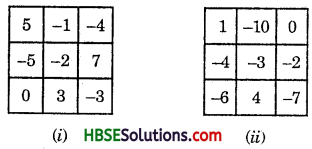



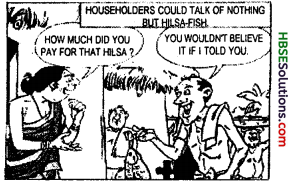
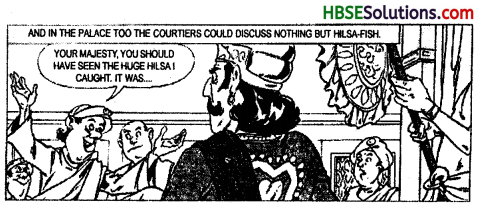
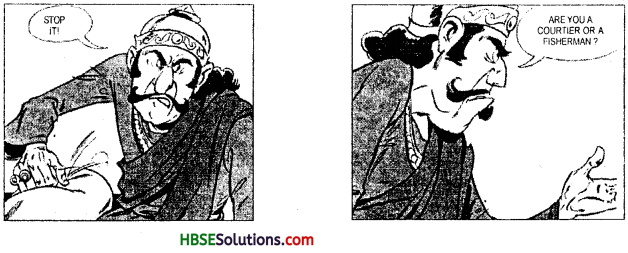
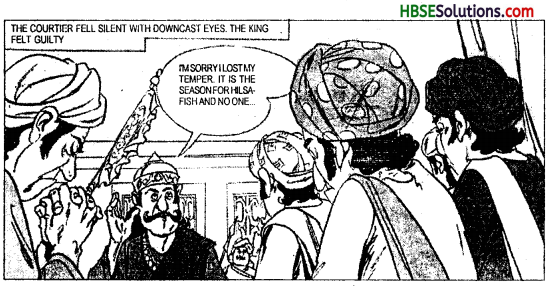
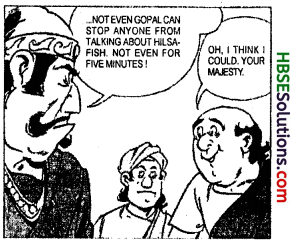


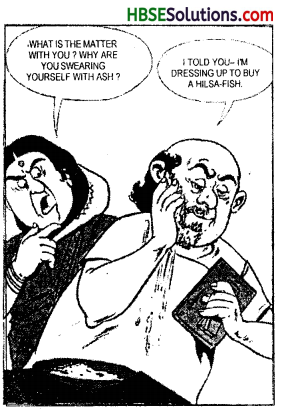
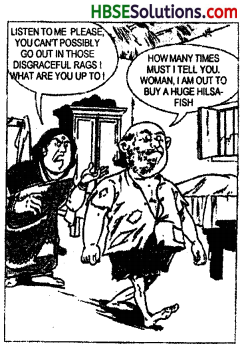
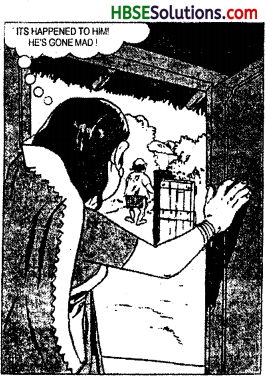
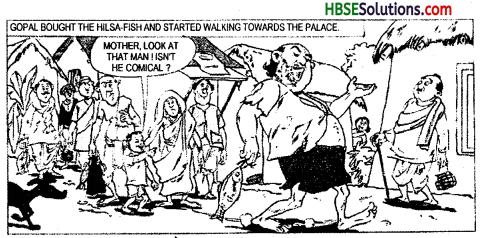
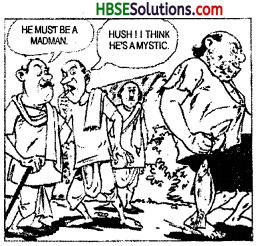


 ‘
‘